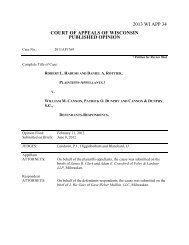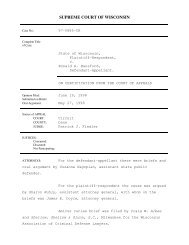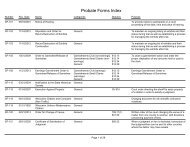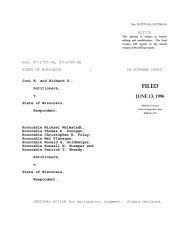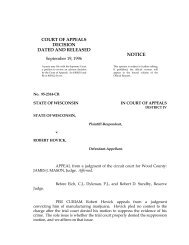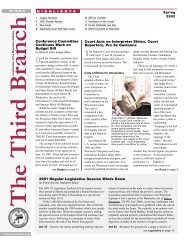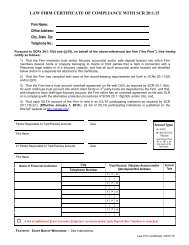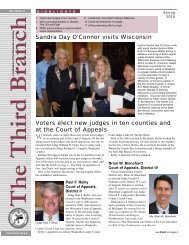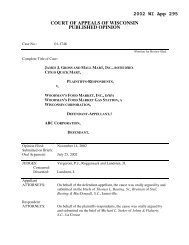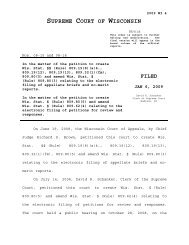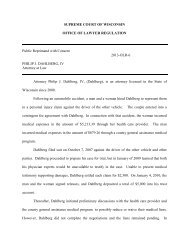Making the Record Committee - Final report - Wisconsin Court System
Making the Record Committee - Final report - Wisconsin Court System
Making the Record Committee - Final report - Wisconsin Court System
Create successful ePaper yourself
Turn your PDF publications into a flip-book with our unique Google optimized e-Paper software.
equested under Trial <strong>Court</strong> Administrative Rule 9 and administrative assignments suchas attendance at court meetings.District 1 uses 16 district court <strong>report</strong>ers, under <strong>the</strong> direct supervision of <strong>the</strong> managingcourt <strong>report</strong>er, who are scheduled on a rotating basis to provide <strong>report</strong>ing services to <strong>the</strong>47 branches of Circuit <strong>Court</strong> in Milwaukee County. These <strong>report</strong>ers, appointed by <strong>the</strong>Chief Judge, are assigned to provide vacation and sick leave coverage for all courts,toge<strong>the</strong>r with workload assistance to court <strong>report</strong>ers in <strong>the</strong> 22 branches of criminal court.In addition, <strong>the</strong>y provide <strong>report</strong>ing services for lengthy or daily copy civil trials, juveniletermination of parental rights trials, preliminary hearings, mental commitment hearings,default divorces and search warrants. Five of <strong>the</strong> district <strong>report</strong>ers are certified real-time<strong>report</strong>ers who also provide real-time services to hearing impaired court participantspursuant to <strong>the</strong> Americans With Disabilities Act (ADA). When district <strong>report</strong>ers are noton <strong>the</strong> record, <strong>the</strong>y are required to be on call to <strong>the</strong> managing court <strong>report</strong>er foremergency court coverage.Official and district circuit court <strong>report</strong>ers are state employees, receiving state-establishedsalaries and fringe benefits. District court administrators are responsible for attemptingto locate a district or substitute official court <strong>report</strong>er to maintain coverage for courtproceedings when <strong>the</strong> official court <strong>report</strong>er is not available. When nei<strong>the</strong>r an official nordistrict <strong>report</strong>er is available, district court administrators are responsible for approvingand assigning freelance court <strong>report</strong>ers, under contract with <strong>the</strong> Director of State <strong>Court</strong>sOffice, to provide <strong>report</strong>ing services. Because of recent years’ budget cuts, <strong>the</strong> use offreelance <strong>report</strong>ers has been significantly reduced: expenditures for freelance <strong>report</strong>ersdropped over 29% from state fiscal year 2000-2001 to state fiscal year 2002-2003.The primary function of <strong>the</strong> court <strong>report</strong>er is to make and preserve <strong>the</strong> record and to latertranscribe it when necessary. When a transcript is requested, <strong>the</strong> court <strong>report</strong>er who made<strong>the</strong> record, whe<strong>the</strong>r official, district or freelance, is responsible for preparing an accurateand timely transcript. Because <strong>the</strong> <strong>report</strong>er is expected to work on transcripts on his orher personal time, <strong>the</strong> transcribing <strong>report</strong>er charges statutorily-set transcript fees for <strong>the</strong>seservices and retains <strong>the</strong> transcript revenue. When prepared by a state-employed court<strong>report</strong>er, <strong>the</strong>se revenues are to be <strong>report</strong>ed to <strong>the</strong> Director of State <strong>Court</strong>s and are treatedas wages for tax and retirement contribution purposes.Currently, <strong>the</strong> vacancy rate for official and district court <strong>report</strong>ers is relatively low. Of<strong>the</strong> 270 official and district court <strong>report</strong>er positions, as of February 16, 2004, <strong>the</strong>re were3.7 vacancies, a 1.4% vacancy rate. In comparison, for budgeting purposes an annual 3%vacancy rate is assumed for all state executive branch agencies. There were an additional2.3 court <strong>report</strong>er positions in leave of absence or leave without pay status.3



